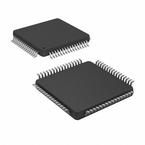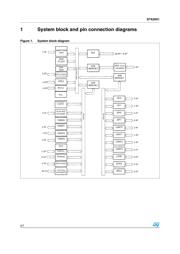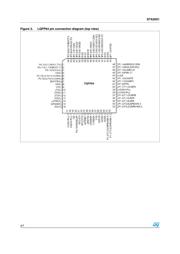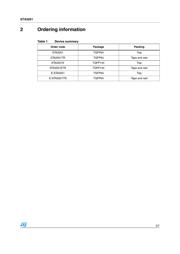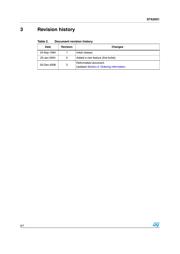herunterladen

Data Brief
For further information contact your local STMicroelectronics sales office.
December 2008 Rev 3 1/7
STA2051
32-bit single chip baseband controller
for GPS and telematic applications
Features
■ Suitable for automotive applications
■ ARM7TDMI 16/32 bit RISC CPU based host
microcontroller.
■ Complete embedded memory system:
– Flash 256 KB + 16 KB (100K
erasing/programming cycles)
– RAM 64 KB
■ External memory interface provides glueless
support for up to four banks of external SRAM,
Flash, ROM.
■ 12 channel GPS correlation DSP:
– no TCXO required
– RTCA-SC159 / WAAS / EGNOS support
■ GPS performance
– accuracy: stand alone <30m; differential
<1m; surveying <1cm
– time to first fix: autonomous start 90s; cold
start 45s; warm start 7s; obscuration 1s.
■ CMOS M8T (0.18 µm) technology.
■ -40°C to 85°C operating temperature range.
■ Packaged in TQFP 64-pin or 144-pin
■ Power supply:
– 2.7V to 3.6V operating supply range for
input/output periphery
– 3V to 3. V operating supply range for A/ D
Converter reference
– 1.8V operating supply range for core supply
provided either by internal voltage regulator
with external stabilization capacitor, or by
external supply for higher power efficiency.
■ 0-66MHz internal clock frequency managed by
a reset and clock control unit; the unitisable to
provide low power modes (Wait, Slow, Stop,
Standby) and to generate the internal clock from
the external reference through integrated PLL.
■ 48 programmable general purpose I/O, each
pin programmable independently as digital
input or digital output; 40 (30 in TQFP64) are
multiplexed with peripheral functions; 16 can
generate an interrupt on input level/transition
■ Real time clock module with 3 2 kHz low power
oscillator and separate power supply to
continue running during stand-by mode.
■ 16-bit watchdog timer with 8 bits prescaler for
system reliability and integrity.
■ CAN module compliant with the CAN
specification V2.0 part B (active). The bit rate
can be programmed up to 1 MBaud.
■ Four16-bit programmable timers with 7 bit
prescaler, up to two input capture/output
compare, one pulse counter function, one
PWM channel with selectable frequency each.
■
4 channels 12-bit sigma-delta analog to digital
converter, single channel or multi channel
conversion modes, single-shotor continuous
conversion modes, sample rate1KHz (4 KHz
when single channel), conversion range 0-2.5V.
■ Three serial communication interfaces (UART)
allow full duplex, asynchronous,
communications with external devices,
independently programmable TX and RX baud
rates up to 625K baud.
■ One UART adapted to suit smart card interface
needs, for asynchronous SC as defined by ISO
7816-3; it includes SC clock generation..
■ Two serial peripheral interfaces (SPI) allow full
duplex, synchronous communications with
external devices, master or slave operation,
max baud rate: 8Mb/s. One SPI may be used
as multimedia card interface.
■ Two I
2
C interfaces provide multi-master and
slave functions, support normal and fast I
2
C
mode (400 kHz), 7/10 bit addressing modes.
One I
2
C interface is multiplexed with one SPI,
so either 2xSPI+1xI
2
C or 1xSPI+2xI
2
C may be
used at a time.
■ USB unit V1.1 compliant, software configurable
end point setting, USB Suspend/Resume
support. (TQFP144 only)
■ High Level Data Link Controller (HDLC) unit
supports full duplex operating mode, NRZ,
NRZI, FM0 and MANCHESTER modes,
internal 8bit Baud Rate Generator.
TQFP64
TQFP144
www.st.com
Verzeichnis

